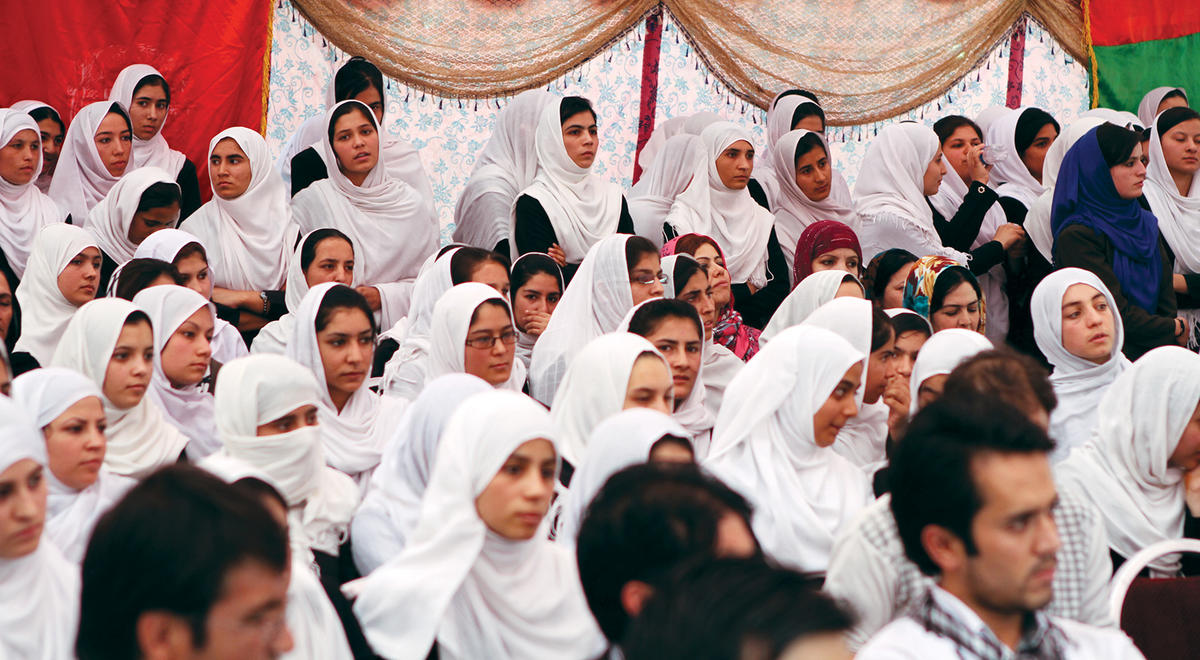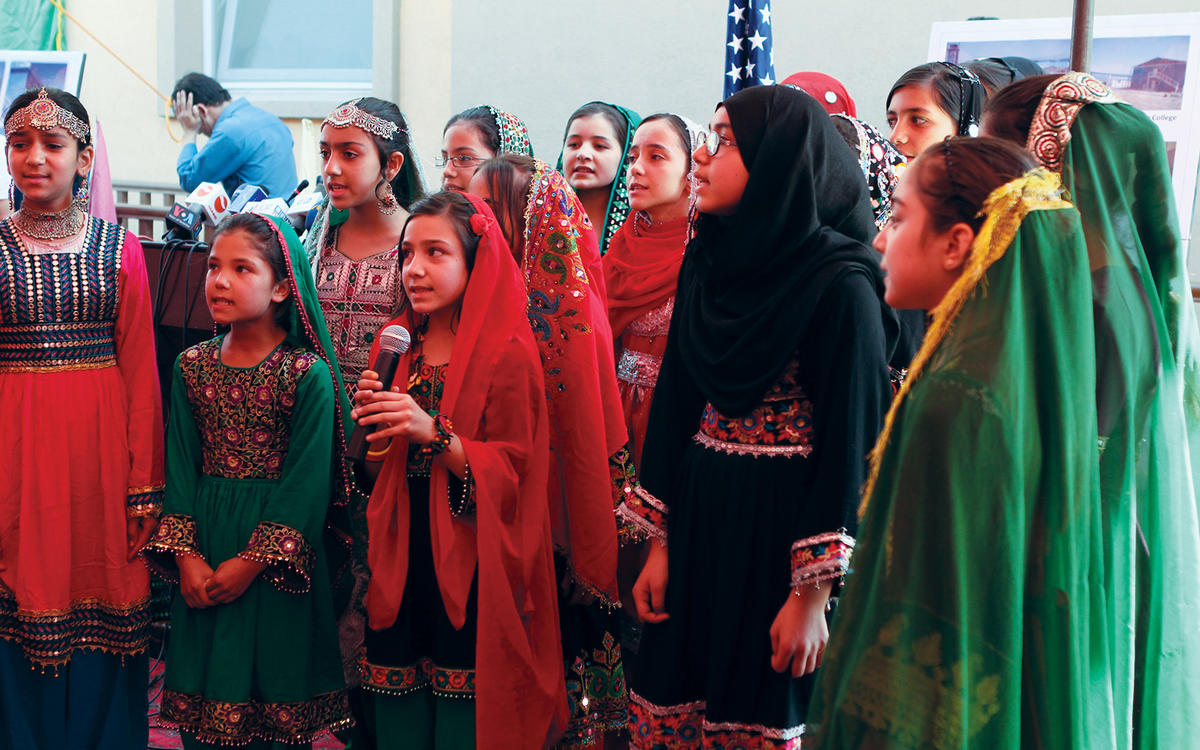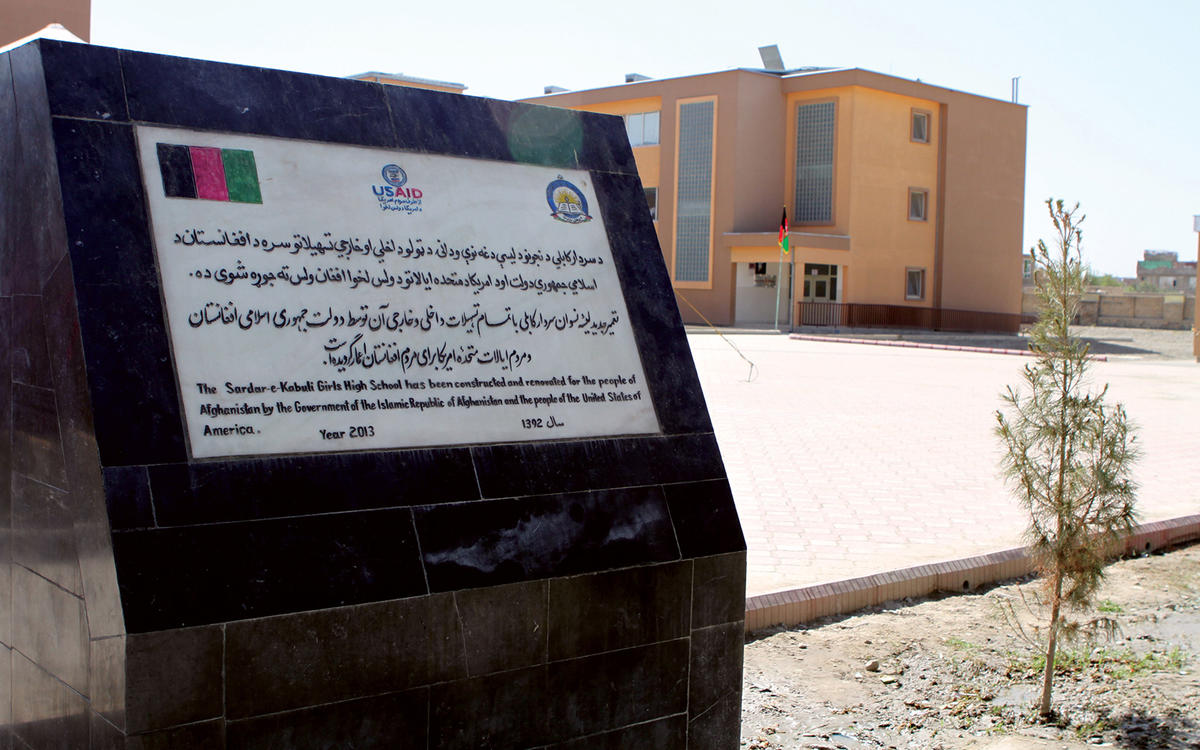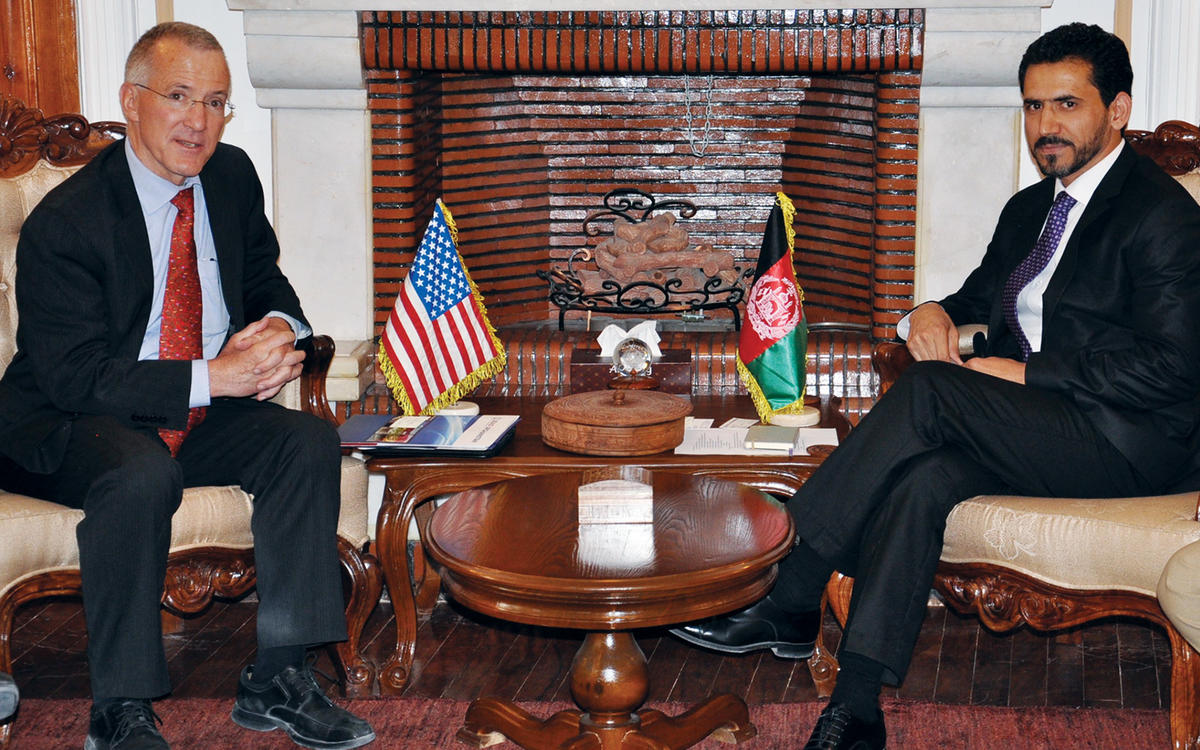USAID in Afghanistan: What Have We Learned?
A retired Senior FSO presents lessons from the largest USAID program since Vietnam, a 17-year engagement that has pushed the agency’s capacity to the hilt.
BY WILLIAM HAMMINK

Students at the dedication ceremony of a new girls’ high school in Kabul.
Photos Courtesy of William Hammink

It was November 2013. Our chopper, carrying U.S. National Security Adviser Susan Rice, flew low and fast over the rooftops of Kabul on our way to the American University of Afghanistan. Launched with a grant from the U.S. Agency for International Development in 2005, AUAF opened its doors to students in 2006. A private, accredited Afghan institution, the university is still dependent on USAID and State funding. Rice spent several hours there hearing from Afghan students, especially young women, about their hopes and plans, both for themselves and their families, and for Afghanistan.
Less than three years later, in August 2016, the university was under siege. Two expatriate professors, one American and one Australian, were seized by the Haqqani network, an insurgent Afghan guerrilla group currently based in Pakistan; days later, terrorists attacked the university with a car bomb and gunmen, killing 17—including seven students—and injuring more than 50. The university closed, temporarily. The professors are still, as of this writing, being held hostage. However, in March 2017 AUAF reopened and now has more than 2,000 students, some 50 percent women. Eleven percent of graduates become Fulbright scholars, the highest percentage in the world.
AUAF is typical of the projects and programs launched by USAID in Afghanistan since 2001. Is it a development success story preparing leaders for Afghanistan’s future, or mainly an unsustainable terrorist target? As a forceful example of the difficulties faced by donors and the Afghan government, what do such projects tell us about trying to carry out sustainable development in a war zone?
One of the Largest USAID Missions in the World
Since returning to Afghanistan in 2001, the U.S. Agency for International Development has been tasked to do many things: bring peace and stability to areas still in, or recovering from, conflict; repair institutions and infrastructure and establish functioning government services; and build for the long term. Some have called it stability operations; others, nation-building. Whatever it is called, it has been the most extensive USAID program since Vietnam—and an effort that has pushed the agency well beyond its traditional boundaries and operational capacity. It remains today, after 17 years, one of the largest USAID missions in the world, in terms of both budget and staffing.
The challenges of trying to do long-term development programs and build government institutions and capacity while also helping to stabilize an insecure and fragile environment are varied and complex. How best to integrate programs to meet urgent political and security objectives with long-term development goals within a framework of ever-changing strategic priorities? How best to carry out critical but sometimes conflicting political, security and development operations and planning in a whole-of-government effort that coordinates agencies including active military? And then there are questions of money. Just how much can money buy; how to account for it; and how much oversight is enough?
The political demands on USAID were so high that the agency shifted an increasing part of its development effort into short-term, quick-response, quick-impact programs in conflict areas.
It is not that we haven’t studied these questions. Numerous studies have sought to capture the lessons learned from the Afghanistan experience, and the learning process is far from over. USAID’s work in Afghanistan continues: so does the learning. This article summarizes a few thoughts based on more than three years of involvement, first as mission director in Kabul and later as head of USAID’s Office of Afghanistan and Pakistan Affairs.
I have seen firsthand that money is not enough; enduring development results will always be difficult to achieve in an active war zone. Progress is complicated by the continuing lack of security, the fragility of government institutions and a lack of agreement—between the government and its supporters, donors and their constituents—on what can be achieved and in what period of time. And it is my experience that whether it concerns the broader interagency, a four-star general or the White House Special Representative, USAID needs to be clear about realistic timelines, sustainability issues and risks. Expectations must be kept reasonable, especially in complex environments.
The Issue of Expectations
The expectations for what USAID, a relatively small agency, could do to support the Department of Defense and State Department’s work in a high-conflict region were unrealistic in terms of what might be achieved, the available time and the resources required. In 2002 Afghanistan was just starting to rebuild from scratch after decades of civil war, poor or nonexistent infrastructure, a lost generation, millions of refugees, extremely low literacy and limited government.
The George W. Bush administration asked USAID to design and implement hundreds of millions of dollars of stabilization programs in direct support of U.S. troops in key terrain districts. This required surging its staff quickly from 100 to 400 American development personnel, who would be posted to provincial reconstruction teams (PRTs) across Afghanistan. USAID then had to push its programs directly through nascent government systems, in essence making a government known for its corruption responsible for up to 50 percent of a multi-billion-dollar program. In short, USAID was asked to undertake a range of work it would normally not undertake—all on an urgent basis and with extraordinary scrutiny from several U.S. government inspectors general and from Congress.
Despite the unrealistic nature of the demands, much has been accomplished. Millions of Afghan children, including millions of young Afghan girls, are in school today. Primary health care has expanded across the country, significantly reducing maternal and under-5 mortality. Life expectancy jumped from 41 years in 2001 to more than 61 years by 2011. Highways, secondary roads, irrigation systems, schools and clinics now exist in much of the country. Electricity now reaches almost 33 percent of the population, up from around 5 percent in 2001. The country’s media are active and vibrant. Last and scarcely least, a functioning government has carried out five elections.
Development takes time. At USAID, we had to constantly remind ourselves that our work has always been more a marathon than a sprint—and not always consistent, unfortunately, with the timelines of our DOD and State colleagues.
The Cost of Surges
Rapid changes in commitment, in terms of budget and staffing, carry costs. In December 2009 President Barack Obama announced a major increase of U.S. troops and civilian employees in Afghanistan. Although the military surge may have had some success, the civilian surge accompanying it was problematic.
USAID was asked to play a major role in the civilian surge by rapidly placing American development and stabilization experts on PRTs, on district support teams and in the regional commands around the country. Because USAID simply did not have enough direct-hire career staff to fill the requirement, the agency had to recruit large numbers of non-U.S. government and development experts quickly from outside of USAID. Because of the urgency of getting civilians into the field, there was no time to adequately train these new employees; many lacked knowledge of USAID and its systems or experience in government. They were generally unable to play the role they could have played with more time and training.
The surge was massive, and it was short-term. By 2011 USAID had 323 direct-hire Americans in Afghanistan, just above 20 percent of the agency’s staff worldwide. But it was only temporary. Even as the surge in the field peaked, the Obama administration decided to begin quickly decreasing the number of civilian staff, especially outside Kabul. The timetable for the military-led closures outside of Kabul dictated a steep withdrawal of USAID and other civilian U.S. government agency personnel. By the end of September 2013, the number of USAID direct-hire Americans had fallen to 217. The decrease continued, and two years later the count was approximately 100—all in Kabul.
Given its whiplash nature, with the pullout of the surged civilians almost as fast as the buildup, it is hard to see any enduring benefits from the civilian surge.

Plaque commemorating the opening of a new girls’ high school in Kabul.
Photo Courtesy of William Hammink
Stabilization and Counterinsurgency: Necessary but Not Sufficient
Stabilization programs are necessary but not sufficient to help communities recover from conflicts. They need to link closely to diplomatic and security efforts to build and maintain peace, to increase citizen and community support for the government and decrease support for insurgents. To work, they need a reasonably secure environment; but they do not have the power to impose security themselves. Despite measurable and meaningful successes in education, health, energy—and even governance—the idea that USAID projects could stabilize a district or counteract armed insurgency has proved aspirational.
Although USAID’s first stabilization program in Afghanistan was launched in 2002 (and managed by the agency’s Office of Transition Initiatives), the 2009 military and civilian surge, with its focus on counterinsurgency, led to a significant expansion of stabilization programming. The agency funded stabilization programs to support the U.S. military’s “clear, hold and build” approach to counterinsurgency in areas designated key terrain districts. The political demands on USAID were so high that the agency shifted an increasing part of its development effort into short-term, quick-response, quick-impact programs in conflict areas.
Four examples stand out: the multi-hundred-million-dollar Stabilization in Key Areas programs, the Afghanistan Vouchers to Increase Production program, the Afghanistan Social Outreach program and the Strategic Provincial Roads Southern and Eastern Afghanistan program. The final reports and audits of these programs were not encouraging. A 2015 Center for American Progress study of the U.S. civilian surge reported that many short-term gains were temporary; that the building of Afghan government functions was unsystematic; and that USAID and other U.S. government civilians in the field were often used to support military tactical efforts rather than to produce strategic shifts in governance or development policy or programs.
A 2016 USAID-funded quantitative assessment on the impact of stabilization programming in Afghanistan found that stabilization programs generally had only a modest impact on violent conflict and other key outcome measures, and that smaller projects were better targeted and less likely to fuel instability and corruption (“Aid and Stabilization in Afghanistan: What Do the Data Say?” USIP, 2017).
The Risks of Going On-Budget
Pushing to deliver assistance through the host government before it is ready carries risks. At the 2010 London Conference for donors aiding Afghanistan, the United States made a political commitment to work toward providing half of all its development assistance on-budget—meaning through Afghan government systems. The intent was to increase the Afghan government’s capacity to carry out its own development programs, decrease the costs of such programs for donors and emphasize local solutions to local problems. These are all worthy objectives. However, this occurred at a time when corruption was rife—in 2013 Afghanistan was tied for last place on Transparency International’s Corruption Perception Index.
USAID Afghanistan had an annual budget of more than $1 billion at the time. To move half of these funds, on top of the on-budget multi-donor trust funds, through government-to-government programs was not only a major challenge institutionally and operationally; it was also very risky. USAID staff in Kabul worked within the agency’s internal accountability rules on host-government financing, negotiating an agreement with the Afghan Ministry of Finance to establish strict safeguards for government-to-government programs.
The expectations for what USAID, a relatively small agency, could do to support Department of Defense and State Department work in a high-conflict region were unrealistic.
USAID put in place several on-budget programs, including in health, education, mines and petroleum, as well as for the national electrical utility and the civil service commission. Expenditures were tracked extremely closely; entire teams in USAID were assigned to oversee each program. Systems were put in place to ensure accountability.
Because the programs were labor-intensive and required constant direct support and oversight, USAID and the government looked for additional approaches. In early 2015, USAID and the Afghan government came up with a better way, an incentive program called the New Development Partnership. The NDP made a substantial part of USAID’s budget available to support the government’s key actions and reforms that showed clear results. Through September 2017, the Afghanistan government had earned $330 million from 17 NDP programs promoting fiscal accountability, good governance and poverty alleviation. The approach has the benefit of increasing government ownership of its own reform agenda and rewarding development successes without the risks of funding government agencies directly.
Strengthening Government Institutions
One overriding objective of the international community in Afghanistan was to help build a sustainable, legitimate and representative government. This would be no small feat after almost three decades of civil war. In late 2001, Afghanistan labored under weak or nonexistent state institutions and a lack of trained civil servants. Significant support was needed to build or rebuild state institutions; to establish rules, systems and procedures; and to train Afghans at all levels to carry out essential governmental functions.
Initially, donors, including USAID, had limited success in helping the Afghans build a skilled civil service workforce because the central government lacked the political will to address issues of patronage and corruption, to introduce reforms or set up a process for hiring employees based on qualifications. Today the political will exists, but donors need to do their part by harmonizing salaries, ensuring that remaining Afghan technical expert contractors are accountable to ministries and using clear metrics for judging performance.
Good Afghan leadership is critical. A big part of the explanation as to why public financial management progressed far further and more quickly than civil service reform, why public health was more effective than agriculture and (in the early years) energy, was Afghan leadership. Better-performing ministries were better led and managed. Donors and technical assistance can do only so much if the government agency is corrupt or ineffective.
In conflict and post-conflict countries, donors and governments need to focus more on the core business functions of government (i.e., human resources systems, financial management, procurement and independent internal audits), support reforms and keep the pressure on the government to be transparent and accountable.

Author William Hammink, left, at a meeting with Afghanistan’s Minister of Agriculture Asadullah Zameer in 2015.
Photo Courtesy of William Hammink
Oversight and Accountability
Accountability is key in a country such as Afghanistan, with difficult travel, an ongoing conflict, huge donor aid budgets and a broad array of programs. That is one reason why Kabul has hosted multiple U.S. government oversight bodies. At one point, at least four oversight agencies had offices in the U.S. embassy compound: inspectors general for USAID and State, the Government Accountability Office and the Special Inspector General for Afghanistan Reconstruction.
Also, Congress understandably wants a level of confidence that USAID knows what is happening on all its projects across Afghanistan, accounts for funds, safeguards investments, tracks results, resolves implementation problems when needed and makes changes to increase impact.
In late 2012 and 2013, as the number of American direct-hire employees shrank and provincial and district coalition bases closed, USAID began working on an expanded monitoring program. This work evolved into a multi-tiered approach that is now fully operational, though the effort to expand and improve continues. Today, the agency relies on a variety of monitoring actors and data points to gather and analyze monitoring data. Each project manager then triangulates the data to ensure confidence in the reporting, and uses the results to make or recommend programmatic decisions.
It is vital that USAID officers involved in planning future interventions review and take to heart the lessons being learned from Afghanistan.
Continued high-level attention from the Department of State and USAID senior management is needed to ensure that the multi-tiered system works bottom-up and top-down, and that decisions can be made in real time to change or de-scope programs quickly to maximize impact, adapt to changes and manage risks.
In addition, in conjunction with other embassy sections and agencies, USAID has established a robust vetting process for all proposed contracts worth more than $25,000 to a non-U.S. entity in Afghanistan, to ensure that there are no links between potential contractors and known terrorists or insurgents. This program works. From May 2011 until May 2017, USAID vetted some 7,883 requests worth close to $4 billion and determined that 347 contracts worth more than $692 million were ineligible, thereby denying support to insurgents and terrorists.
Looking Forward
USAID will no doubt be asked again to move well beyond its normal comfort zone as part of another U.S. intervention in pursuit of urgent national security objectives. It is vital that USAID officers involved in planning these interventions review and take to heart the lessons being learned from Afghanistan. While USAID showed it could successfully carry out challenging and difficult U.S. policies in Afghanistan (e.g., stabilization, on-budget support and a short-term civilian surge), its efforts carried high costs and high risks. Here are a few things we should keep in mind for all similar efforts going forward:
• Do not try to do everything. More staff, including huge civilian surges, does not mean better programs; and more money cannot address political corruption or structural, systemic, historical and cultural impediments to development in the short term. USAID needs to be more selective in crisis countries, even with multi-billion-dollar budgets.
• Stick to proven development principles. As much as possible, proven development principles—such as local ownership, local systems, sustainability, evidence-based design and implementation, strong monitoring and evaluation, country ownership, and focus on institutions and local capacity—should be maintained and the requisite analyses carried out up front.
• Flexibility and adaptability are key. Mechanisms and approaches should be in place to maximize flexibility for the agency and for the host government—for example, in shifting funding, narrowing activities and moving them to different geographic areas—given constant changes and fluctuating opportunities. Headquarters needs to fully support any new flexible arrangements.
• Expect and plan for high levels of oversight. Develop an agreement with the various agencies’ inspectors general, GAO and congressional staff, when possible, on monitoring and risk mitigation. In a high-risk, political and conflict-driven environment, develop and ensure constant senior-level attention to a robust monitoring system that also tracks security incidents. Management systems should be set up to make real-time decisions on project activities.
In summary, what, in fact, do we learn from the American University of Afghanistan and other USAID projects in Afghanistan? At a minimum, we see that U.S. assistance can make a difference in individual lives, and that we can develop institutions that are positioned to make a difference over the long term, although sustainability remains a major issue. We also learn that our work to improve lives involves huge risks. Just as the potential gains from programming civilian assistance in a conflict zone should not be exaggerated, neither should the risks and costs be underestimated.
Read More...
- “Will We Ever Learn? An Evaluation of U.S. Aid in Afghanistan”
- “Afghanistan: A Synthesis Paper of Lessons from Ten Years of Aid”
- “Lessons Learned from Stabilization Initiatives in Afghanistan: A Systematic Review of Existing Research”
- “What U.S. Policymakers Should Know about Afghanistan Today”
- “Redesigning Foreign Aid”








